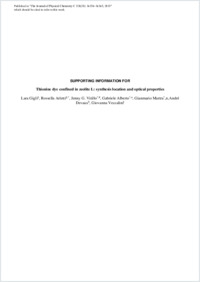Thionine dye confined in zeolite L: synthesis location and optical properties
- Gigli, Lara Dipartimento di Scienze della Terra, Università degli Studi di Torino, Italy
- Arletti, Rossella Dipartimento di Scienze della Terra, Università degli Studi di Torino, Italy - Nanostructure Interfaces and Surfaces, Centre of Excellence, Torino, Italy
- Vitillo, Jenny G. Nanostructure Interfaces and Surfaces, Centre of Excellence, Torino, Italy - Dipartimento di Scienze ad Alta Tecnologia, Università degli Studi dell’Insubria, Como, Italy
- Alberto, Gabriele Nanostructure Interfaces and Surfaces, Centre of Excellence, Torino, Italy - Dipartimento di Chimica, Università degli Studi di Torino, Italy
- Martra, Gianmario Nanostructure Interfaces and Surfaces, Centre of Excellence, Torino, Italy
- Devaux, André Department of Chemistry, University of Fribourg, Switzerland
- Vezzalini, Giovanna Dipartimento di Scienze Chimiche e Geologiche, Università degli Studi di Modena, Italy
-
16.07.2015
Published in:
- The Journal of Physical Chemistry C. - 2015, vol. 119, no. 28, p. 16156–16165
English
The process of light conversion is at present deeply investigated to develop more efficient devices for artificial photosynthesis, water splitting, photovoltaic applications, and targeting therapeutic agents. This process is induced by nanostructured functional materials, such as zeolites light sensitized by dye molecules adsorbed into their pores. Here a detailed study of the organization of the cationic dye thionine (Th) inserted into the linear 12MR channels of zeolite L is carried out by XRPD, FT-IR spectroscopy—for the determination of the host–guest interactions—and UV–vis absorption and photoluminescence spectroscopies for the investigation of the electronic states of the guest. Two composites with different Th loading (labeled ZL/0.15Th and ZL/0.27Th) were obtained through ion exchange. TGA spectra and IR-ATR spectroscopy clearly indicated penetration of Th molecules into the ZL channels. Rietveld structural refinement showed that Th molecules in both composites are aligned parallel to the 12MR channel axis and located on the mirror planes parallel to the c-axis. Water molecules interact strongly with the dye and form a kind of solvent–matrix tube shaped around the Th molecule, favoring the upright arrangement of the molecules. DR–UV–vis spectra of the ZL/Th composites indicated that Th molecules are hosted in the ZL channels in a monomeric form. Photoluminescence spectroscopy demonstrated that photoluminescent dyes correspond to ca. 5% of the total amount of Th molecules in the zeolite porosities. While most of the photoluminescent Th molecules exhibit a lifetime equivalent to Th in solutions, the complementary fraction of photoluminescent Th exhibit significantly longer lifetimes, resulting from an entrapment in defects of the zeolite structure, inducing strong rotational constraints to the molecules.
- Faculty
- Faculté des sciences et de médecine
- Department
- Département de Chimie
- Language
-
- English
- Classification
- Chemistry
- License
-
License undefined
- Identifiers
-
- RERO DOC 257150
- DOI 10.1021/acs.jpcc.5b04717
- Persistent URL
- https://folia.unifr.ch/unifr/documents/304479
Other files
Statistics
Document views: 103
File downloads:
- pdf: 311
- Supplementary material: 147

